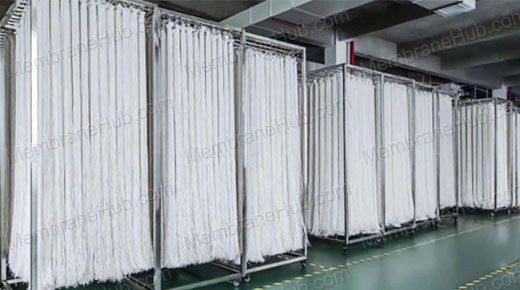The six conditions for the operation of MBR membrane mainly include inlet water quality, membrane surface flow rate, temperature, working pressure, pH value, MLSS, etc.

1. The working temperature of MBR membrane should be in the range of 15~35°C. In general, the increase of temperature and the increase of membrane flux are mainly due to the increase in temperature, the viscosity of the sludge mixture decreases, and the permeability resistance decreases.
2. When the working pressure is controlled and the mixing characteristics of activated sludge are basically unchanged, the membrane flux increases with the increase of pressure. However, when the pressure reaches a certain value, the concentration of solute on the surface of the membrane reaches the limit concentration due to the concentration of concentration difference, and it is difficult to increase the membrane flux by increasing the pressure, but aggravates the membrane pollution. The transmembrane pressure difference of immersion MBR should not exceed 0, 05Mpa.
3. Dissolved oxygen is an important factor affecting the removal effect of organic matter. Especially under the condition of phosphorus and nitrogen removal, the control of dissolved oxygen concentration is particularly important. In various membrane bioreactor processes, the mixture forms an aerobic fraction in various forms in the bioreactor. Hypoxic and anaerobic segments. The control range of each stage of the reactor is: 0, 2mg/l below the anaerobic section, 0, 2mg/l, 0, 5mg/l, the aerobic section of the dissolved oxygen concentration is not less than 2mg/l.
4. The effect of membrane velocity and membrane velocity on membrane flux is correlated. Under low pressure conditions, the membrane rate has little effect on the membrane flux. Under high pressure conditions, the membrane rate has a great influence on the membrane flux. Membrane flux increases with membrane rate, especially at high pressures. This is because increasing the membrane velocity increases the shear force of the water flow and reduces the deposition of contaminants on the membrane surface. Increasing the flow velocity can increase the convective mass coefficient, reduce the thickness of the boundary layer, and reduce its concentration polarization effect. In addition, the effect of film velocity on the sediment layer is also related to the sludge concentration in the feed liquid. At lower concentrations, the permeability of the film layer is linearly related to the film velocity. However, when the sludge concentration is high, the influence on the sedimentary layer decreases and the growth rate of the membrane flux decreases when the membrane velocity increases to a certain value. For the external MBR, the operating conditions should be controlled in the low and large flow range as much as possible, and the operating conditions should be kept at 3m/s~5m/s/s as much as possible. This not only helps to maintain a high water flux, but also facilitates the maintenance and maintenance of the membrane, reducing the cleaning and replacement of the membrane.
5. The sludge concentration in the aerobic zone (pool) of MLSS immersion MBR should be controlled at 3000mg/L~20000mg/L. Generally speaking, at a certain membrane velocity, the greater the sludge concentration and the higher the sludge concentration, the easier it is for the sludge to be deposited on the membrane surface, resulting in the formation of a thick layer, and the filtration resistance and membrane flux will decrease. However, the sludge concentration in the feed liquid should not be too low, otherwise the pollutant degradation rate is not high, and the adsorption and degradation ability of activated sludge to dissolved organic matter is weakened, so that the concentration of dissolved organic matter in the supernatant of the mixed liquid increases, and it is easy to be adsorbed by the membrane surface, the filtration resistance increases, and the membrane flux decreases. Therefore, the sludge concentration in the feed liquid should be kept moderate. Too high or too low will reduce the flow of moisture.
6. The pH value of the inlet water of the membrane bioreactor should be 6~9
Contact: Ms. Maggie
Phone: +86 133 7628 2682
Tel: +86 133 7628 2682
Email: thomas.huang@membranehub.com
Add: The east side of Binjiang Intelligent Equipment Enterprise Port 10#, No. 90, Gangqu Middle Road, Weicun Street, Xinbei District, Changzhou City, Jiangsu Province
We chat
